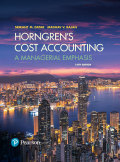
EBK HORNGREN'S COST ACCOUNTING
16th Edition
ISBN: 9780134475950
Author: Datar
Publisher: PEARSON CO
expand_more
expand_more
format_list_bulleted
Question
Chapter 21, Problem 21.21E
1.
To determine
Capital Budgeting:
It refers to the long term investment decisions that has been taken by the top management of a company and that are irreversible in nature. These decisions require investment of large amount of cash of the company.
To identify: Amount accumulated at the end of 5 years.
2.
To determine
To identify: Present value of investment.
3.
To determine
To identify: Value of investment at the end of each year.
4.
To determine
To identify: Value of investment at the end of 8th year.
5.
To determine
To identify: Value that can be withdrawn at the end of each year.
6.
To determine
To identify: Value of investment to earn required annual
7.
To determine
To identify: The desirable plan.
Expert Solution & Answer
Want to see the full answer?
Check out a sample textbook solution
Students have asked these similar questions
General accounting question
Can you help me solve this general accounting problem with the correct methodology?
compute the accrued interest ....???
Chapter 21 Solutions
EBK HORNGREN'S COST ACCOUNTING
Ch. 21 - Capital budgeting has the same focus as accrual...Ch. 21 - List and briefly describe each of the five stages...Ch. 21 - Prob. 21.3QCh. 21 - Only quantitative outcomes are relevant in capital...Ch. 21 - How can sensitivity analysis be incorporated in...Ch. 21 - Prob. 21.6QCh. 21 - Describe the accrual accounting rate-of-return...Ch. 21 - Prob. 21.8QCh. 21 - Lets be more practical. DCF is not the gospel....Ch. 21 - All overhead costs are relevant in NPV analysis....
Ch. 21 - Prob. 21.11QCh. 21 - Distinguish different categories of cash flows to...Ch. 21 - Prob. 21.13QCh. 21 - How can capital budgeting tools assist in...Ch. 21 - Distinguish the nominal rate of return from the...Ch. 21 - A company should accept for investment all...Ch. 21 - Prob. 21.17MCQCh. 21 - Which of the following statements is true if the...Ch. 21 - Prob. 21.19MCQCh. 21 - Nicks Enterprises has purchased a new machine tool...Ch. 21 - Prob. 21.21ECh. 21 - Capital budgeting methods, no income taxes. Yummy...Ch. 21 - Capital budgeting methods, no income taxes. City...Ch. 21 - Prob. 21.24ECh. 21 - Capital budgeting with uneven cash flows, no...Ch. 21 - Comparison of projects, no income taxes. (CMA,...Ch. 21 - Payback and NPV methods, no income taxes. (CMA,...Ch. 21 - DCF, accrual accounting rate of return, working...Ch. 21 - Prob. 21.29ECh. 21 - Prob. 21.30ECh. 21 - Project choice, taxes. Klein Dermatology is...Ch. 21 - Prob. 21.32ECh. 21 - Selling a plant, income taxes. (CMA, adapted) The...Ch. 21 - Prob. 21.36PCh. 21 - NPV and AARR, goal-congruence issues. Liam...Ch. 21 - Payback methods, even and uneven cash flows. Sage...Ch. 21 - Replacement of a machine, income taxes,...Ch. 21 - Recognizing cash flows for capital investment...Ch. 21 - NPV, inflation and taxes. Fancy Foods is...Ch. 21 - NPV of information system, income taxes. Saina...
Knowledge Booster
Similar questions
- Please provide the solution to this financial accounting question using proper accounting principles.arrow_forwardBelow is information for Blue Company. Using this information, answer the following questions on the "Calculation" tab in the file. Show your work (how you got your answer) and format appropriately. Blue company has prepared the following contribution format income statement based on a sales volume of 1,000 units (the relevant range of production is 500 to 1,500 units): Sales $ 40,000 Variable expenses 24,000 Contribution margin 16,000 NOTE: Use the amounts in the original fact pattern to the left as your basis for the questions below. Fixed expenses 12,000 Net operating income $ 4,000 Questions: 1. What is the contribution margin per unit? 2. What is the contribution margin ratio? 3. What is…arrow_forwardI am looking for help with this financial accounting question using proper accounting standards.arrow_forward
- General accountingarrow_forwardPlease explain the correct approach for solving this general accounting question.arrow_forwardRobin Corporation has ordinary income from operations of $30,000, net long-term capital gain of $10,000, and net short-term capital loss of $15,000. What is the taxable income for 2010? a) $25,000. b) $27,000. c) $28,500. d) $30,000. e) None of the above.arrow_forward
- Please explain the solution to this financial accounting problem using the correct financial principles.arrow_forwardI need the correct answer to this financial accounting problem using the standard accounting approach.arrow_forwardI am trying to find the accurate solution to this general accounting problem with the correct explanation.arrow_forward
arrow_back_ios
SEE MORE QUESTIONS
arrow_forward_ios
Recommended textbooks for you
- Principles of Accounting Volume 2AccountingISBN:9781947172609Author:OpenStaxPublisher:OpenStax College
 Cornerstones of Financial AccountingAccountingISBN:9781337690881Author:Jay Rich, Jeff JonesPublisher:Cengage Learning
Cornerstones of Financial AccountingAccountingISBN:9781337690881Author:Jay Rich, Jeff JonesPublisher:Cengage Learning

Principles of Accounting Volume 2
Accounting
ISBN:9781947172609
Author:OpenStax
Publisher:OpenStax College


Cornerstones of Financial Accounting
Accounting
ISBN:9781337690881
Author:Jay Rich, Jeff Jones
Publisher:Cengage Learning